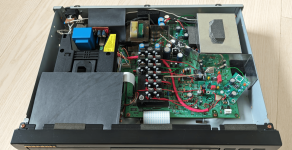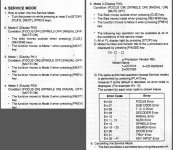You don't know until you prove something. These switches do oxidize, it's very common. So while you are there, test it to actually see what condition it is in.
You can infer that the switch is serviceable for now the time you checked it. That's fine as a quick check, by why not make it so you know for certain and clean if needed while you are there? That eliminates a repeat disassembly later.
Also, make certain the mechanical does engage the switch properly. That eliminates that possibility.
The loading motor should not operate at all if the tray is fully in. It may or may not if the tray is fully out depending on the program (most do retract the tray automatically).
I'm trying to do is help you deal with it. The biggest reason something may be unsolvable is because people make assumptions instead of knowing for sure. Test, know, prove.
You can infer that the switch is serviceable for now the time you checked it. That's fine as a quick check, by why not make it so you know for certain and clean if needed while you are there? That eliminates a repeat disassembly later.
Also, make certain the mechanical does engage the switch properly. That eliminates that possibility.
The loading motor should not operate at all if the tray is fully in. It may or may not if the tray is fully out depending on the program (most do retract the tray automatically).
I'm trying to do is help you deal with it. The biggest reason something may be unsolvable is because people make assumptions instead of knowing for sure. Test, know, prove.
This may well be so but would need to be checked by measuring the motor voltages.There were no problems with that so I'm wondering if, upon initial power up, the machine automatically checks that the tray is fully withdrawn by means of a quick pulse to the motor which lasts no more than a second, and I assume that with a sufficiently tight belt and the tray where it should be the motor wouldn't rotate.
I tested with my CD-43 and CD-67 test rigs - I cannot hear any motor rotation. But since the belts are in good condition then there would be nothing to hear. Maybe in the coming days I have time to remove the cover from one of them and capture the motor voltage waveform during power up cycle.
The uP shouldn't have to read anything but the limit switch, that's all. Only if the switch indicates the tray is not homed should the motor run on power-up. It also indicates the CDM is up and chucked.
Running a stalled DC motor is pretty hard on the brushes, driver transistors (or IC) and power supply. Not an intelligent plan at all. Still, you never know what goofy ideas some designers come up with. For me, this indicates the switch isn't good, or it is not being actuated. I guess the wire or PCB pad could be open, but when the switch was manually operated the uP did sense it.
Running a stalled DC motor is pretty hard on the brushes, driver transistors (or IC) and power supply. Not an intelligent plan at all. Still, you never know what goofy ideas some designers come up with. For me, this indicates the switch isn't good, or it is not being actuated. I guess the wire or PCB pad could be open, but when the switch was manually operated the uP did sense it.
The service manual shows WN187164 as the chip responsible for the the tray motor, pin 17, but frustratingly I can't find a datasheet anywhere for that chip in order to read what happens at power up on pin 17. When I fit the new belt I will measure the switch resistance but I think its unlikely to be the problem as its only at power up for 1 second, and regardless of whether the machine has been off for 12 hours or just a couple of seconds it behaves exactly the same each time. I agree about running a stalled motor.
No, it doesn't matter how long it was off. The uP gets a reset whenever power is cycled.
The driver chip is commanded by the uP or Mech controller. It just does what it is told.
Simple test. Look at the connections to the switch at the PCB, mechanism totally reassembled. Home the tray and power off. Measure the contacts to see if one set of contacts is closed. When powering up, that closed contact pair should probably be at logic zero (measure volts, I use a scope to look for noise).
If you have a clean logic low (or maybe high) that doesn't change with the motor running, I guess it may be programmed. Also, there may be two switches. One for tray in, the other detects when the transport has been fully raised. It only needs one, but I have seen two limit switches. If either is noisy or open, it will run the loading motor. If the mech doesn't actuate either switch properly, it will run the loading motor. Check the other if it exists the same way.
Really stupid if it is programmed to run that motor no matter the switch state.
The driver chip is commanded by the uP or Mech controller. It just does what it is told.
Simple test. Look at the connections to the switch at the PCB, mechanism totally reassembled. Home the tray and power off. Measure the contacts to see if one set of contacts is closed. When powering up, that closed contact pair should probably be at logic zero (measure volts, I use a scope to look for noise).
If you have a clean logic low (or maybe high) that doesn't change with the motor running, I guess it may be programmed. Also, there may be two switches. One for tray in, the other detects when the transport has been fully raised. It only needs one, but I have seen two limit switches. If either is noisy or open, it will run the loading motor. If the mech doesn't actuate either switch properly, it will run the loading motor. Check the other if it exists the same way.
Really stupid if it is programmed to run that motor no matter the switch state.
Thank you again. Here's what I don't understand, if the switch is causing the problem then why is the unwanted motor running only at start up and only for a second, wouldn't it be more erratic/unpredictable?
Hi Tim,
Not necessarily.
Normally for CD players (and VCRs), the controller detects the position of mechanism parts. If it doesn't find the mech in a known state, it will run a motor to place the mechanism in a known state. If the various switches are closed ( or open depending), then the controller knows where everything is and it's happy. It does nothing.
Therefore, when you see something as you are, normally either a switch is bad, or the mechanism is not actuating the switch. Sticky lubricants, worn/broken parts or slipping belts can cause this.
Could they have programmed this? Sure, but it is not normal and it is also pretty stupid. I have seen this with really cheap stuff occasionally.
Not necessarily.
Normally for CD players (and VCRs), the controller detects the position of mechanism parts. If it doesn't find the mech in a known state, it will run a motor to place the mechanism in a known state. If the various switches are closed ( or open depending), then the controller knows where everything is and it's happy. It does nothing.
Therefore, when you see something as you are, normally either a switch is bad, or the mechanism is not actuating the switch. Sticky lubricants, worn/broken parts or slipping belts can cause this.
Could they have programmed this? Sure, but it is not normal and it is also pretty stupid. I have seen this with really cheap stuff occasionally.
I have cleaned the switch contacts with IPA. It measures below 0.1R (my meter's limit) so I think it's fine. I also notice the switch is open when the loading tray is closed so it can't be the switch causing the problem. The new belt should arrive today so I'll fit that. I'm also hoping to obtain another machine to compare and keep for spares etc.
Now with the new belt fitted the closed loading tray visibly moves slightly on the left side at power on as the motor is activated, so I shall covert it to manual push/pull open/close.
Okay, both good news.
Is there a switch to show the mechanism is fully raised? There will be one for the laser head to be fully inwards (it will not affect the loading cycle). Just look for more limit switches in there.
Don't convert it to manual - not yet anyway.
Is there a switch to show the mechanism is fully raised? There will be one for the laser head to be fully inwards (it will not affect the loading cycle). Just look for more limit switches in there.
Don't convert it to manual - not yet anyway.
No there isn't, the only other switch is for the laser sled. I now have another 63 on the way so I'll soon be able to compare.
Hi Tim.Hi, I've acquired a CD63OSE which has a small issue and I'm hoping somebody here can point me in the right direction to fix it. When switching the unit on, and when the loading tray is already fully closed, the loading tray motor spins for a second or two before stopping. In all other respects it behaves perfectly. Does anybody have an idea what might be causing the problem? Thanks in advance.
Sorry for being a little late to the party. I dough out my old 63 and fired it up. I does exactly the same. Then I compared it with my second 63 - it does the same. I guess it's by design. Yours perfect all right.
Attachments
Thank you avr300, that's interesting and very useful to know. You've been very busy with yours I notice!
Measured the power on sequence of tray motor on my CD-43 (same product family as CD-63) - the tray motor is powered for about 1 second when powering on the player (even with closed tray).
Motor spins during that time and it is audible.

Motor spins during that time and it is audible.
madis64, thank you. In my machine a new belt stopped the motor from spinning but I wonder for how long. I think its fair to say this is a design fault.
Thanks, yes, I looked at this and concluded it wouldn't reveal a design fault.Don't forget the CD63 has a self-test service mode you can try! From the manual - as attached.
Well, perhaps it was another layer of security for the limit switch contact activation position tolerance.I think its fair to say this is a design fault.
When the tray is being pulled in then - after closing the switch contacts and deactivating the motor the tray most probably moves to the physical stop by inertia.
When starting up the player it may have moved outwards "just a tiny bit" so that switch contacts are still engaged and designers wanted to be sure that the tray is in its physical limit position before proceeding with the startup sequence.
Just guessing...
- Home
- Source & Line
- Digital Source
- Marantz CD63 & CD67 mods list

